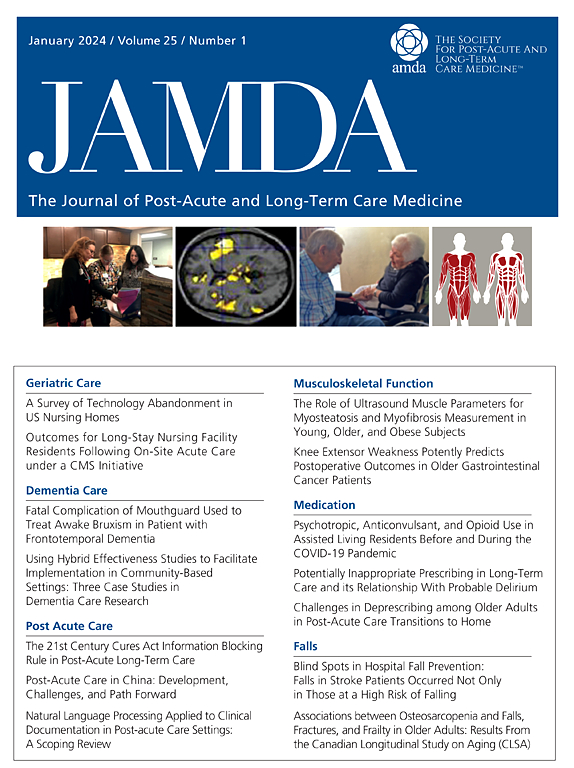Excessive Burden of Hyperglycemia Along With Hypoglycemia in Long-Term Care Facilities Identified by Continuous Glucose Monitoring
IF 4.2
2区 医学
Q2 GERIATRICS & GERONTOLOGY
Journal of the American Medical Directors Association
Pub Date : 2025-04-24
DOI:10.1016/j.jamda.2025.105590
引用次数: 0
Abstract
Objectives
Recommendations for diabetes care in long-term care facilities (LTC) focus on the avoidance of hypoglycemia and symptomatic hyperglycemia. Using continuous glucose monitoring (CGM), we evaluated the current state of glycemia in LTC residents with multiple comorbidities.
Design
Cross-sectional prospective observational study.
Settings and Participants
Participants with diabetes on 1 or more glucose-lowering medications residing in 1 of 8 LTC facilities in Ohio and Michigan.
Methods
A masked Dexcom G6 pro CGM was placed for 10 days on LTC residents. Clinical and demographic information was collected from medical records.
Results
Sixty-five residents [median age 68 years (range 44–84 years), 51% female, 100% with type 2 diabetes] completed the study. Overall, 68% of the cohort used insulin and 64% were on non-insulin agents (11% on sulfonylurea). The mean A1c of the cohort was 7.2% ± 1.5%. CGM data showed 26% of the cohort with ≥1% time spent in hypoglycemia (time <70 mg/dL). A larger burden of severe hyperglycemia (sensor glucose >250 mg/dL) was seen, with 52% of the cohort spending >10% time, 37% spending >25%, and 18% spending >50% time in severe hyperglycemia. The cohort had a median of 13 comorbid conditions, taking 19 medications daily, with 86% having functional disabilities and 63% reporting a recent fall. Fifty-four percent of the cohort had a body mass index (BMI) >30 kg/m2 and 22% had a BMI >40 kg/m2.
Conclusions and Implications
In this multimorbid cohort of residents with diabetes living in LTC facilities, we identified a high burden of both hypoglycemia and severe hyperglycemia, despite optimal control of A1c. More consistent use of CGM may help to identify glycemic excursions and actionable glucose patterns to improve therapeutic decision-making by clinicians.
通过持续血糖监测确定长期护理机构中高血糖和低血糖的过度负担
目的:长期护理机构(LTC)对糖尿病护理的建议侧重于避免低血糖和症状性高血糖。使用连续血糖监测(CGM),我们评估了患有多种合并症的LTC患者的血糖现状。设计横断面前瞻性观察研究。环境和参与者:居住在俄亥俄州和密歇根州8家LTC机构中的1家的糖尿病患者服用一种或多种降糖药物。方法将蒙面Dexcom G6 pro CGM放置于LTC患者10 d。从医疗记录中收集临床和人口统计信息。结果65名居民完成了研究[中位年龄68岁(44-84岁),女性51%,100%患有2型糖尿病]。总体而言,68%的队列患者使用胰岛素,64%的患者使用非胰岛素药物(11%使用磺脲类药物)。该队列的平均A1c为7.2%±1.5%。CGM数据显示,26%的患者处于低血糖状态的时间≥1%(时间≤70 mg/dL)。严重高血糖(传感器血糖250 mg/dL)的负担更大,52%的队列患者在严重高血糖中花费10%的时间,37%花费25%的时间,18%花费50%的时间。该队列平均有13种合并症,每天服用19种药物,86%有功能障碍,63%报告最近跌倒。54%的人体重指数(BMI)为30 kg/m2, 22%的人体重指数(BMI)为40 kg/m2。结论和意义在这个居住在LTC设施的多病糖尿病患者队列中,我们发现了低血糖和严重高血糖的高负担,尽管A1c得到了最佳控制。更一致地使用CGM可能有助于识别血糖偏离和可操作的血糖模式,以改善临床医生的治疗决策。
本文章由计算机程序翻译,如有差异,请以英文原文为准。
求助全文
约1分钟内获得全文
求助全文
来源期刊
CiteScore
11.10
自引率
6.60%
发文量
472
审稿时长
44 days
期刊介绍:
JAMDA, the official journal of AMDA - The Society for Post-Acute and Long-Term Care Medicine, is a leading peer-reviewed publication that offers practical information and research geared towards healthcare professionals in the post-acute and long-term care fields. It is also a valuable resource for policy-makers, organizational leaders, educators, and advocates.
The journal provides essential information for various healthcare professionals such as medical directors, attending physicians, nurses, consultant pharmacists, geriatric psychiatrists, nurse practitioners, physician assistants, physical and occupational therapists, social workers, and others involved in providing, overseeing, and promoting quality

 求助内容:
求助内容: 应助结果提醒方式:
应助结果提醒方式:


